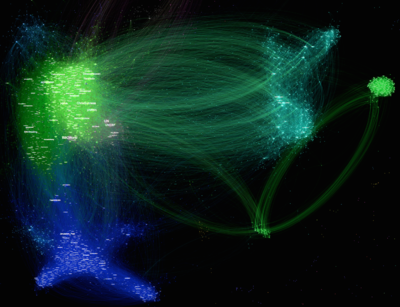Homophily
From Deliberative Democracy Institiute Wiki
Twitter and facebook are knowen to make debates more homophilies[1]. This a represntation of debate about the israeli(blue)-Palestinian (green) conflict in Gaza in 2014.
from Madan, Anmol et al.(2011)[2]:
- Homophily, or the idea of "birds of a feather flock together", [30] is a fundamental and pervasive phenomenon in social networks, and refers to the tendency of individuals to form relationships with others that have similar attributes, behaviors or opinions. Homophily commonly occurs in empirical network data, and has been extensively studied as a sociological phenomenon. McPherson and Smith [37] provide an in depth review of homophily literature. The emergence of homophily during network formation has be explained using agent based models,and in economics [14] by incorporating chance, choice, and tie formation costs.
- In sociological literature, homophily is estimated using the homophily index Hi, and Coleman's inbreeding homophily index, IHi. If wi is the relative fraction of individuals within the community with opinion i, Hi is defined as the averaged ratio of same-type ties to total ties for individuals with opinion type i, and IHi is measured as the amount of bias with respect to baseline homophily as it relates to the maximum possible bias (i.e., the term 1 wi) [14, 37]. For an invariant the network structure, the relationship between homophily index Hi and relative fraction wi reects the type of homophily. If wi > wj implies Hi > Hj , then the parameters satisfy relative homophily. If Hi = wi for all i, then the parameters satisfy baseline homophily. If Hi > wi for type i, then the parameters satisfy inbreeding-homophily, i.e. the tendency of friendships to be biased towards own types beyond the effect of relative population size. Finally, in some cases, the opposite may be true, such that Hi < wi for type i, wherein the parameters satisfy heterophily and people of type i are biased towards having different-type friendships. In terms of the Coleman index, inbreeding homophily for type i exists if and only if IHi > 0, and inbreeding heterophily for type i if and only if IHi < 0. The inbreeding homophily index is 0 if there is pure baseline homophily, and 1 if a group completely inbreeds.
See Also
References
- ↑ Himelboim, I., McCreery, S., & Smith, M. (2013). Birds of a Feather Tweet Together: Integrating Network and Content Analyses to Examine Cross-Ideology Exposure on Twitter. Journal of Computer-Mediated Communication, 18(2), 40–60.
- ↑ Madan, Anmol et al. “Pervasive Sensing to Model Political Opinions in Face-to-Face Networks.” Pervasive Computing. Ed. Kent Lyons, Jeffrey Hightower, & Elaine M. Huang. Berlin, Heidelberg: Springer Berlin Heidelberg, 2011. 214-231.
